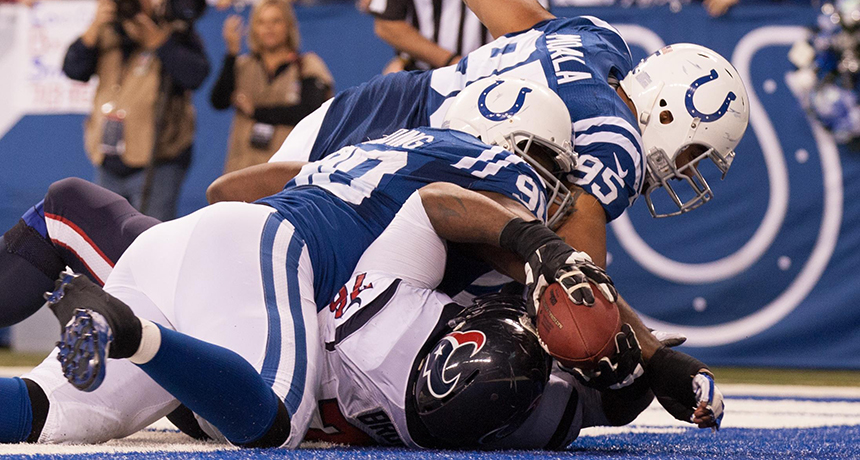Football and hockey players aren’t doomed to suffer brain damage
Tests on former pro athletes’ brains shows the tissues in better shape than expected

NO HEAD START For a small group of former Buffalo Bills football players and Buffalo Sabre hockey players, a career full of head slams didn’t inevitably lead to early dementia, a new study found.
John Green/AgencyCal Sport Media/Alamy
- More than 2 years ago
A career of hard hits to the head doesn’t inevitably lead to brain decline, a small study of former football and hockey pros suggests. The results counter a specter raised by other studies on pro football players’ brains after death.
The new findings come from extensive brain scans and behavioral tests of 21 retired athletes — football players from New York’s Buffalo Bills and hockey players from the Buffalo Sabres. In a series of papers published August 7 in the Journal of Head Trauma Rehabilitation, researchers report finding no signs among the athletes of early dementia or mental slipping. Those symptoms are early hallmarks of the brain disease chronic traumatic encephalopathy, or CTE, which can be diagnosed by a brain examination only after death.
Such studies involving living subjects “are exactly what we really need,” says cognitive neuroscientist and psychologist Carrie Esopenko of Rutgers University in Newark, N.J. “They are really going to help us understand what’s going on in these lives, rather than what’s happening when they’re dead.”
Using a battery of clinical tests, researchers at the University at Buffalo measured brain function and mental health, while also investigating other aspects of the ex-players’ health, such as diet, body mass index and history of drug and alcohol use. The team then compared the results with the same measures taken for 21 noncontact athletes, including runners and cyclists.
Participating football players and hockey players expected bad news. They “were pretty much their own worst critics,” believing themselves to be impaired, says coauthor and psychiatrist Barry Willer.
Instead, tests conducted by researchers turned up no problems with memory, problem solving, decision making or the ability to plan. Nor did tests of attention, language and spatial ability reveal any deficits. Based on this battery of tests, none of the contact athletes could be diagnosed with early-onset dementia.
Eight out of 21 contact athletes seemed to have mild cognitive impairment, a clinical diagnosis that’s a prelude to dementia, compared with three out of the 21 other athletes. That difference could be explained by discrepancies in education, IQ and body mass index, and didn’t hold up to statistical tests, the authors write.
Magnetic resonance imaging of the brains told a similar story. Multiple types of MRI found no big differences in brain anatomy or behavior between contact athletes and noncontact athletes. In fact, seven of the noncontact athletes showed microbleeds, or tiny blood vessel ruptures associated with worse brain functioning, compared with only two of the contact athletes.
The good news “was a big surprise to us, and a big surprise to the athletes,” Willer says. The results are in line with several earlier studies of living athletes, including one in 2017 by Esopenko and colleagues in the Journal of Neurology, Neurosurgery and Psychiatry that found no major problems in the mental abilities of 33 retired hockey pros.
The new study may ease concerns raised last year, when researchers reported in JAMA that 110 of 111 post-mortem brains of former pro football players had CTE (SN: 8/19/17, p. 15). Those brains were donated by family members who suspected something was amiss, possibly leading the sample to include more CTE diagnoses than other populations. “People who do not have symptoms do not donate their brains,” says neurologist Rodolfo Savica, of the Mayo Clinic in Rochester, Minn., who was not involved in either study. Because of that inevitable bias, the earlier study couldn’t answer how common CTE is among athletes who incur repetitive head blows.
The new study’s participants were in their mid-50s, relatively young for a dementia diagnosis, so it’s possible that symptoms could appear later. Still, based on earlier reports of brain damage, the researchers expected to find some signs of dementia in this group.
To better understand the prevalence of CTE, though, more research is needed on a larger sample of athletes who suffer blows to the head as well as those who don’t, researchers say. “There’s a lot more that we don’t know than we do know,” says coauthor John Leddy, director of the Concussion Management Clinic at the University of Buffalo.






